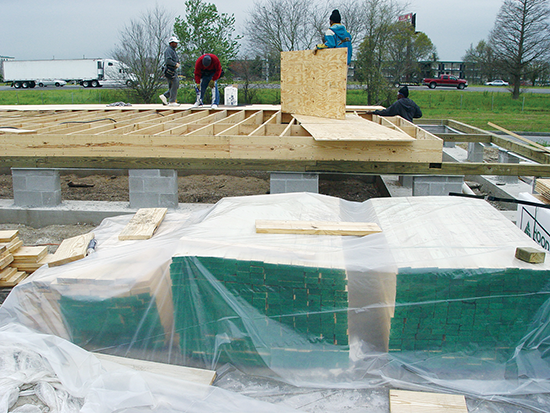Storing lumber correctly may seem simple, but it’s much more than throwing a tarp over a pile of Southern Pine. Proper seasoning, storage, and handling are essential to ensure dimensional stability, reduce shrinkage, and preserve lumber quality throughout construction and service life.
Why Moisture Content Matters
To minimize shrinkage, the Southern Pine Inspection Bureau’s Standard Grading Rules for Southern Pine Lumber require dimension lumber 2 inches or less to be kiln-dried or seasoned to a maximum moisture content of 19%. At the time of manufacture, this typically results in an average moisture content near 15%.
As lumber acclimates to its installation environment, additional conditioning occurs:
- Interior applications (flooring, millwork, furniture)
- Average moisture content: 6%–11%
- Range depends on regional climate (dry Southwest vs. humid Gulf South)
- Exterior applications (framing, siding, sheathing)
- Average moisture content: 7%–14% across most U.S. climates
Proper receiving, unloading, storage, installation, and bracing help maintain this stability and protect material quality.
Best Practices for Storing Lumber on the Jobsite
Follow these simple rules to maintain lumber quality and performance:
- Inspect deliveries immediately: Check for proper grade stamps, moisture content, and issues such as mold.
- Unload in a dry, clean location: Avoid muddy or standing-water areas.
- Elevate lumber on stringers: This prevents ground moisture absorption and improves air circulation.
- Avoid direct ground contact: Ground contact can cause rapid moisture uptake and decay.
- Cover outdoor piles properly: Use materials that protect from rain and UV exposure. Tip: Polyethylene and other non-porous covers can trap moisture—allow for ventilation to reduce condensation.
- Enclose framing lumber under a roof ASAP: Faster protection = better performance.
- Store exterior patterns outdoors but covered: Ideal for siding, porch flooring, and trim profiles.
- Store interior materials indoors: Flooring, millwork, and cabinetry should acclimate within the conditioned space where they’ll be installed.
Additional Protection Options
Some lumber is shipped in paper-wrapped packages or with weather-protective coatings. Keep in mind:
- Availability can be limited
- Coatings are generally effective only 3–6 months
- Torn or damaged wrap reduces protection
- Protection ends once the wrap is removed
Key Takeaway
Pressure-treated wood is safe, durable, and environmentally responsible when properly stored and installed. The same storage guidelines used for untreated lumber apply to pressure-treated products—stack it elevated, keep it ventilated, and shield it from excess moisture.
Learn More
Explore the Southern Forest Products Association’s complete Pressure-Treated Southern Pine technical publication for guidance on moisture content, handling, installation, and safety best practices.
